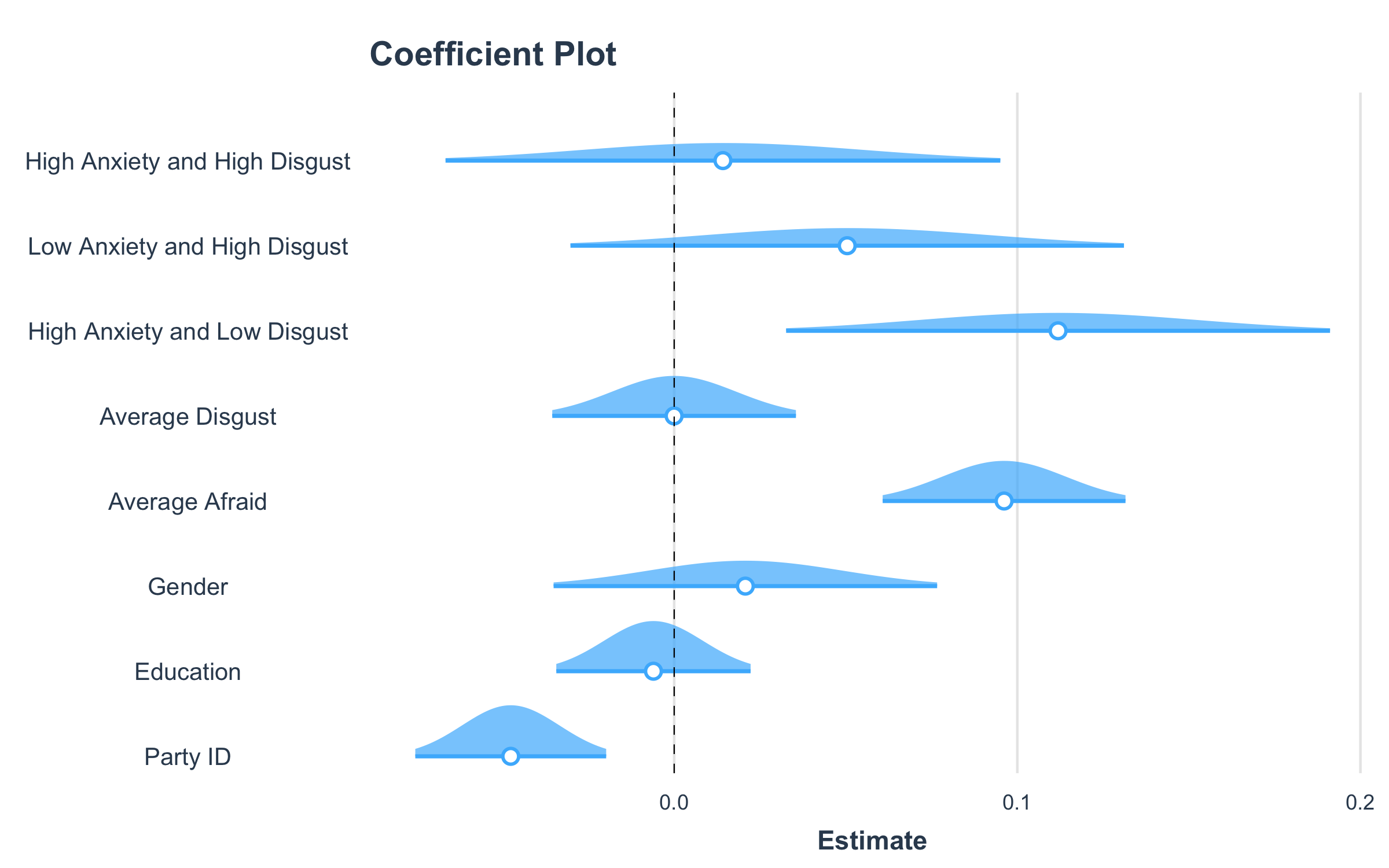This blog is part of a series related to Gov 1372: Political Psychology, a course at Harvard University taught by Professor Ryan D. Enos.
Using data from Clifford and Jerit’s (2018), this week I explore their findings about the effects of disgust and anxiety on political learning. Through a series of experiments manipulating information about a disease, they find that people who were disgusted were less likely to seek out more information. I show this effect from their data and then discuss real world implications of this finding.
Background
Disgust and anxiety are two common emotions that people feel in their daily lives. In Clifford and Jerit’s (2018), they measure people’s feelings of disgust and anxiety to determine how these feelings lead to other actions such as wanting to learn more information or recalling things that caused these emotions. They conduct two studies, both looking at how people responded to a fake disease. I will only be evaluating data from the first study in this blog. The first study was an experiment run through a survey administered by YouGov in December of 2015. People were asked to read about a fake disease and respond to some questions afterwards. The treatment effect was divided into the following four groups describing the disease:
- Low Anxiety/Low Disgust
- High Anxiety/Low Disgust
- Low Anxiety/High Disgust
- High Anxiety/High Disgust
And for each emotion (anxiety and disgust), the authors used 3 different indexes to measure each emotion.
The Data
In the data, the following coded variables are of interest to us in this blog:
requestInfo: requested additional information be sent to them (1-Yes, 0-No)treat_rand1: treatment variable (1-Low Anxiety/Low Disgust, 2-High Anxiety/Low Disgust, 3-Low Anxiety/High Disgust, and 4-High Anxiety/High Disgust)avg_disgust: average of the three disgust indexes for each respondent (disgust, grossed out, and repulsed)avg_anxiety: average of the three anxiety indexes for each respondent (afraid, anxious, and worried)gender: self-reported gender (1-Female, 0-Not Female)educ: self-reported education (1-No HS, 2-High school graduate, 3-Some college, 4-2 year degree, 5-4 year degree, 6-Post-graduate degree)pid: self-reported partisanship (1-Strong Democrat, 2-Not very strong Democrat, 3-Lean Democrat, 4-Independent, 5-Lean Republican, 6-Not very strong Republican, 7-Strong Republican, 8-Not Sure)
I used these variables to evaluate the relationship between the treatment and emotion indexes while controlling for gender, education, and partisanship on whether a person requested more information about the fake disease. The coefficient plot is shown below.

From this coefficient plot, we can see that people in the high anxiety and low disgust treatment group and people who were more afraid while controlling for other variables were groups that on average were more likely to request more information about the disease at a statistically significant level than the control group. Interestingly, partisanship had on average an effect of being less likely to request more information as one’s partisanship shifted more to the right at a statistically significant level. However, when comparing this to the real world example of the COVID-19 pandemic, this makes sense as Republicans tended to be less concerned about the virus and therefore were probably also less likely to request more information about COVID-19 (at least accurate information…).
People in the two treatment groups with high levels of disgust were also more likely than the control group to request more information, however at a lower rate than people in the high anxiety and low disgust group and not at a statistically significant level. What this tells me is that not all people in the high disgust groups were so disgusted that they did not want more information about the disease. However, some people in those groups would be less likely on average than those in the high anxiety and low disgust group to request more information. But what would be the real world implications of this? Is there a way to make something disgust less disgusting?
Conclusion
From the data in Clifford and Jerit’s (2018), we can see that people who were in the high anxiety and low disgust group on average were more likely to request information while controlling for other variables than the control group and groups with high disgust treatment. The real world implications of this is that messaging aimed at making people want to learn more about something potentially harmful (like smoking or climate change) should not have tones of disgust in them. For example, I think about the CDC commercials that I sometimes see showcasing how smoking can lead to lung cancer or disgusting teeth. I would say that these commercials aimed at scaring people by making people disgusted are likely not a great way to convince current smokers to want to learn more on how they can quit.
On the other hand, and depending on the situation, adding a tone that makes people anxious might be good in terms of making people want to learn more. I think this is especially applicable in terms of climate change and pushing countries to drastically switch to clean energy solutions to help reduce emissions. We need to really emphasize to people that harms of climate change like a rising sea level could devastate populous cities currently under sea level. Other examples might include a planet that might be no longer safe for
